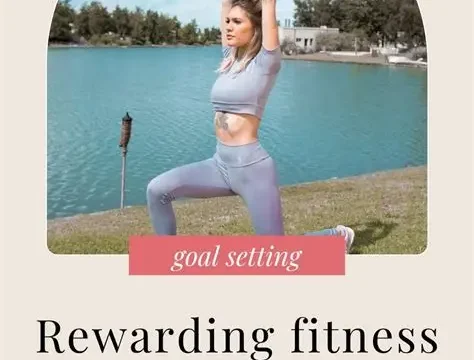When it comes to fitness, the goals you set can either fuel your motivation or quietly drain it.
Many people start with the best intentions but quickly lose steam when their goals feel overwhelming, unrealistic, or rooted in comparison.
The good news is that fitness goals don’t have to be extreme or intimidating.
In fact, the most effective and uplifting goals are often the ones that keep you feeling positive, capable, and proud of your progress. Setting fitness goals that boost your mindset starts with redefining success. Instead of tying your goals only to numbers on a scale or how you think your body should look, shift the focus toward how you want to feel. Do you want more energy during the day? Would you like to feel stronger when doing everyday tasks? Are you hoping to improve your sleep, manage stress, or boost your confidence? These types of outcomes are often more meaningful and sustainable than appearance-based targets. One helpful way to stay positive is to keep your goals rooted in what’s realistic and relevant to your current lifestyle. Life is full of responsibilities, routines, and unexpected changes. If your goal requires a total overhaul of your schedule or energy levels, it may be difficult to maintain. That doesn’t mean you can’t aim high. It just means starting with goals that feel attainable right now, so each success builds momentum instead of pressure. Short-term goals can be incredibly powerful when they lead into longer-term aspirations. For example, if your dream is to run a 5K, your first goal might be to walk or jog for ten minutes a few times a week. If you’d like to build upper body strength, you might begin with a few push-ups a day and increase over time. Every goal you set should feel like something you can achieve and celebrate, not something that makes you feel behind before you’ve even begun. Another great strategy for staying positive is to set goals around consistency rather than perfection. Instead of focusing on what happens in a single workout or measuring every little detail, focus on the habit you’re building. A goal like “move my body four times this week” offers flexibility and reduces guilt if plans shift. You’re not aiming for flawless execution—you’re aiming for regular, supportive movement that fits into your life. It also helps to choose goals that bring some enjoyment or curiosity into your routine. If you hate running, then “run every morning” probably won’t keep you smiling for long. But if you love music, a goal like dancing to three songs a day might be more energizing. If you like the outdoors, daily walks in nature could be the perfect way to stay active and uplifted. When your goals align with what you genuinely enjoy, positivity tends to follow naturally. Celebrating small wins along the way is another essential part of setting goals that lift your spirits. Too often, people skip past their progress in pursuit of something bigger. But each step you take matters. Whether it’s completing a week of workouts, trying a new exercise for the first time, or simply showing up on a day when you didn’t feel like it, every effort is worth acknowledging. When you recognize and appreciate your progress, you reinforce the habit and keep your mindset strong. Mindset plays a huge role in whether fitness goals feel like an exciting opportunity or a stressful obligation. Try to approach your goals with a spirit of curiosity rather than criticism. If a certain plan doesn’t go as expected, that doesn’t mean you’ve failed. It means you’re learning what works for your body and lifestyle. Be open to adjusting your goals when necessary. Flexibility is not weakness—it’s wisdom. It’s also helpful to pair your physical goals with goals that support your mental and emotional well-being. Fitness is about much more than muscles or endurance. It’s about how you care for yourself as a whole person. Goals like reducing stress through yoga, practicing deep breathing during cooldowns, or taking rest days to recharge can keep your mindset balanced and positive. When your wellness plan includes your mental and emotional needs, your motivation has deeper roots. Staying positive also means resisting the urge to compare your journey to someone else’s. In today’s world, it’s easy to scroll through highlight reels on social media and feel like you’re not doing enough. But fitness isn’t about doing what others do—it’s about discovering what makes you feel your best. Your goals are unique to your body, your schedule, and your experiences. Progress doesn’t need to be dramatic to be meaningful. What matters is that you’re moving forward in a way that’s right for you. Support systems can also make a big difference in keeping your goals positive and motivating. Whether it’s a friend who walks with you, a workout buddy who joins you at the gym, or even a group online where you can share milestones, surrounding yourself with encouragement can help you stay committed. Sharing your goals with others also adds a layer of accountability, which often leads to greater consistency. Another positive approach is to use visual reminders to stay motivated. You could create a vision board that reflects how you want to feel, post uplifting quotes where you’ll see them each morning, or track your workouts in a way that gives you a sense of accomplishment. These small touches add joy and meaning to your routine and serve as gentle nudges to keep going. Of course, rest and recovery should be part of your goal-setting too. A positive fitness routine includes time to recharge. If you push too hard without allowing for rest, it’s easy to lose your enthusiasm. Setting goals around sleep, hydration, and stress management can help you stay balanced and energized. When your whole routine supports your health, you’re far more likely to enjoy it and stick with it. At the end of the day, the best fitness goals are those that add something good to your life. They make you feel proud, not pressured. They build your energy, not drain it. They lift your confidence and remind you that you’re capable of growth at any pace. So as you consider your next set of goals, think about what feels doable, enjoyable, and kind to your body. Think about how you want to feel when you finish a workout, and what kind of routine will help you carry that feeling into your everyday life. And above all, trust that your journey doesn’t have to be extreme to be effective. It just has to be yours.



